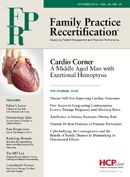Publication
Article
Family Practice Recertification
Scribes and Their Role in the Medical Community
Author(s):
As the workload for doctors increases some practices and hospitals are turning to scribes to help with some of the duties. What they should be doing and how much involvement they should have remains a topic of discussion.

The electronic health record (EHR) and e-prescribing are powerful tools critical to the success of the American healthcare system achieving the so-called “triple aim”: better care for individuals, better health for populations, and lower per-capita costs. Despite being the focus of over $20 billion in federal funding from the American Recovery and Reinvestment Act of 2009, the widespread acceptance and effective use of these tools has been hindered by numerous factors, not the least of which has been resistance and dissatisfaction at the clinician level.
By requiring them during the course of a patient encounter to function not only in the role of doctor but also typist, medical coder, and documenter of level of service, many physicians have found these tools often impede, rather than enable, efficient clinical care. The incessant need for data entry (both at the time of the patient encounter as well as after-hours), interference with face-to-face patient care time, and impedance of workflow are just some of the aspects of health IT use that has fueled discontentment. The use of medical scribes has emerged as one approach to helping relieve the burden associated with medicine's transition to computerized documentation.
A medical scribe has been defined by the Joint Commission as “an unlicensed individual hired to enter information into the EHR or chart at the direction of a physician or licensed independent practitioner”. Medical scribes, who may be employed by healthcare organizations, medical practices, individuals, or subcontracted from a scribe service, generally receive 1-3 months of training and come at a typical cost of $15-$30 per hour.
The general duties of a scribe can include composing and typing clinic and procedure notes as directed by the practitioner, locating information for review such as reports, test results and laboratory results, submitting diagnoses and billing codes, printing out patient education materials, and generating communications (such as letters and referrals) to other providers. In addition, following review and authentication by the physician, scribes can also enter orders for laboratory tests or diagnostics, nursing orders, as well as electronic prescriptions directed to the patient’s pharmacy.
Early returns on the utility of medical scribes in Emergency Departments (ED) as well as specialty practices have been positive based on the metrics studied. Studies have shown improvement in physician productivity based on the number of patients seen in a day as well as resource value units (RVU) generated. Patient experience surveys have demonstrated unchanged or improved patient satisfaction scores with the use of scribes facilitating a more patient-centric encounter in these settings. Surveys of participating physicians, whose clerical workloads are reduced by scribes, also demonstrate good satisfaction scores.
In terms of operation and priorities, family medicine and primary care practices are distinctly different from ED and specialty practices, and perceived downsides of using medical scribes have dampened enthusiasm for their use. The sanctity of doctor-patient relationship is critical to the comprehensive, continuous, and personal care provided by family physicians and the intrusion of a scribe into the relationship runs the risk of undermining confidentiality and compromising the relationship.
Economic considerations also play a role with many practices reluctant to add another layer of cost to its operation. Others question the wisdom of inserting an intermediary between the physician and the EHR, citing the potential for introducing inaccuracies, omissions, and errors into the medical record and diluting the potential value of built-in, “real-time” computer alerts and prompts designed to make the clinician cognizant of relevant clinical guidelines, health maintenance reminders, scheduled tests, and drug interactions.
At present, I have difficulty seeing how the inclusion of a third party in the exam room would not adversely impact the trust and intimacy of the doctor-patient relationship family physicians strive to achieve. The findings that reduced patient satisfaction has not been apparent in the emergency department or specialty practice settings is not surprising in light of the episodic, limited spectrum of care typically provided.
Although the use of a “virtual” medical scribe (one housed in a remote location) could allay, at least in part, some of my concerns and the prospect of having a data-entry “personal assistant” is appealing, how well this luxury (and its attendant costs) aligns with the overarching objective of achieving the “triple aim” remains to be seen.






